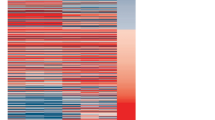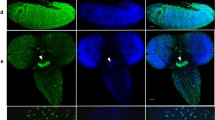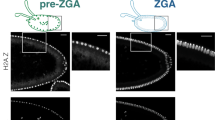Abstract
In yeast cells, the THO complex has been implicated in mitotic recombination, transcription elongation and mRNA nuclear export. The stable core of THO consists of Tho2p, Hpr1p, Mft1p and Thp2p. Whether a complex with similar functions assembles in metazoa has not yet been established. Here we report that Drosophila melanogaster THO consists of THO2, HPR1 and three proteins, THOC5–THOC7, which have no orthologs in budding yeast. Gene expression profiling in cells depleted of THO components revealed that <20% of the transcriptome was regulated by THO. Nonetheless, export of heat-shock mRNAs under heat stress was strictly dependent on THO function. Notably, 8% of upregulated genes encode proteins involved in DNA repair. Thus, although THO function seems to be conserved, the vast majority of mRNAs are transcribed and exported independently of THO in D. melanogaster.
This is a preview of subscription content, access via your institution
Access options
Subscribe to this journal
Receive 12 print issues and online access
$189.00 per year
only $15.75 per issue
Buy this article
- Purchase on Springer Link
- Instant access to full article PDF
Prices may be subject to local taxes which are calculated during checkout









Similar content being viewed by others
References
Chávez, S. et al. A protein complex containing Tho2, Hpr1, Mft1 and a novel protein, Thp2, connects transcription elongation with mitotic recombination in Saccharomyces cerevisiae. EMBO J. 19, 5824–5834 (2000).
Jimeno, S., Rondón, A.G., Luna, R. & Aguilera, A. The yeast THO complex and mRNA export factors link RNA metabolism with transcription and genome instability. EMBO J. 21, 3526–3535 (2002).
Strässer, K. et al. TREX is a conserved complex coupling transcription with messenger RNA export. Nature 417, 304–308 (2002).
Libri, D. et al. Interactions between mRNA export commitment, 3′-end quality control, and nuclear degradation. Mol. Cell. Biol. 22, 8254–8266 (2002).
Piruat, J.I. & Aguilera, A. A novel yeast gene, THO2, is involved in RNA pol II transcription and provides new evidence for transcriptional elongation-associated recombination. EMBO J. 17, 4859–4872 (1998).
Rondón, A.G., Jimeno, S., García-Rubio, M. & Aguilera, A. Molecular evidence that the eukaryotic THO/TREX complex is required for efficient transcription elongation. J. Biol. Chem. 278, 39037–39043 (2003).
Schneiter, R. et al. The Saccharomyces cerevisiae hyper-recombination mutant hpr1Δ is synthetically lethal with two conditional alleles of the acetyl coenzyme A carboxylase gene and causes a defect in nuclear export of polyadenylated RNA. Mol. Cell. Biol. 19, 3415–3422 (1999).
West, R.W. Jr., Kruger, B., Thomas, S., Ma, J. & Milgrom, E. RLR1 (THO2), required for expressing lacZ fusions in yeast, is conserved from yeast to humans and is a suppressor of SIN4. Gene 243, 195–205 (2000).
Chang, M. et al. A complex containing RNA polymerase II, Paf1p, Cdc73p, Hpr1p, and Ccr4p plays a role in protein kinase C signaling. Mol. Cell. Biol. 19, 1056–1067 (1999).
Fan, H.Y., Merker, R.J. & Klein, H.L. High-copy-number expression of Sub2p, a member of the RNA helicase superfamily, suppresses hpr1-mediated genomic instability. Mol. Cell. Biol. 21, 5459–5470 (2001).
Zenklusen, D., Vinciguerra, P., Wyss, J.C. & Stutz, F. Stable mRNP formation and export require cotranscriptional recruitment of the mRNA export factors Yra1p and Sub2p by Hpr1p. Mol. Cell. Biol. 22, 8241–8253 (2002).
Stutz, F. et al. REF, an evolutionary conserved family of hnRNP-like proteins, interacts with TAP/Mex67p and participates in mRNA nuclear export. RNA 6, 638–650 (2000).
Stutz, F. & Izaurralde, E. The interplay of nuclear mRNP assembly, mRNA surveillance and export. Trends Cell Biol. 13, 319–327 (2003).
Strässer, K. & Hurt, E. Yra1p, a conserved nuclear RNA-binding protein, interacts directly with Mex67p and is required for mRNA export. EMBO J. 19, 410–420 (2000).
Zenklusen, D., Vinciguerra, P., Strahm, Y. & Stutz, F. The yeast hnRNP-like proteins Yra1p and Yra2p participate in mRNA export through interaction with Mex67p. Mol. Cell. Biol. 13, 4219–4232 (2001).
Strässer, K. & Hurt, E. Splicing factor Sub2p is required for nuclear mRNA export through its interaction with Yra1p. Nature 413, 648–652 (2001).
Lei, E.P. et al. Messenger RNAs are recruited for nuclear export during transcription. Genes Dev. 15, 1771–1782 (2001).
Lei, E.P. & Silver, P.A. Intron status and 3′-end formation control cotranscriptional export of mRNA. Genes Dev. 16, 2761–2766 (2002).
Jensen, T.H., Dower, K., Libri, D. & Rosbash, M. Early formation of mRNP: license for export or quality control? Mol. Cell 11, 1129–1138 (2003).
Huertas, P. & Aguilera, A. Cotranscriptionally formed DNA-RNA hybrids mediate transcription elongation impairment and transcription-associated recombination. Mol. Cell 12, 711–721 (2003).
Zhou, Z., Licklider, L.J., Gygi, S.P. & Reed, R. Comprehensive proteomic analysis of the human spliceosome. Nature 419, 182–185 (2002).
Herold, A., Teixeira, L. & Izaurralde, E. Genome-wide analysis of nuclear mRNA export pathways in Drosophila. EMBO J. 22, 2472–2483 (2003).
Gatfield, D. et al. The DExH/D-box protein HEL/UAP56 is essential for mRNA nuclear export in Drosophila. Curr. Biol. 11, 1716–1721 (2001).
Gatfield, D. & Izaurralde, E. REF1/Aly and the additional exon junction complex proteins are dispensable for nuclear mRNA export. J. Cell Biol. 159, 579–588 (2002).
Longman, D., Johnstone, I.L. & Caceres, J.F. The Ref/Aly proteins are dispensable for mRNA export and development in Caenorhabditis elegans. RNA 9, 881–891 (2003).
MacMorris, M., Brocker, C. & Blumenthal, T. UAP56 levels affect viability and mRNA export in Caenorhabditis elegans. RNA 9, 847–857 (2003).
Altschul, S.F. et al. Gapped BLAST and PSI-BLAST: a new generation of protein database search programs. Nucleic Acids Res. 25, 3389–3402 (1997).
Echalier, G. Drosophila Cells in Culture (Academic Press, San Diego, 1997).
Yost, H.J. & Lindquist, S. RNA splicing is interrupted by heat-shock and is rescued by heat-shock protein synthesis. Cell 45, 185–193 (1986).
Chávez, S., Garcia-Rubio, M., Prado, F. & Aguilera, A. Hpr1 is preferentially required for transcription of either long or G+C-rich DNA sequences in Saccharomyces cerevisiae. Mol. Cell. Biol. 21, 7054–7064 (2001).
Aguilera, A. The connection between transcription and genomic instability. EMBO J. 21, 195–201 (2002).
Weber, C.H. & Vincenz, C. The death domain superfamily: a tale of two interfaces? Trends Biochem. Sci. 26, 475–481 (2001).
Fulop, V. & Jones, D.T. β-propellers: structural rigidity and functional diversity. Curr. Opin. Struct. Biol. 9, 715–721 (1999).
Herold, A., Klimenko, T. & Izaurralde, E. NXF1/p15 heterodimers are essential for mRNA nuclear export in Drosophila. RNA 7, 1768–1780 (2001).
Le Hir, H., Gatfield, D., Braun, I.C., Forler, D. & Izaurralde, E. The protein Mago provides a link between splicing and mRNA localization. EMBO Rep. 2, 1119–1124 (2001).
Nott, A., Le Hir, H. & Moore, M.J. Splicing enhances translation in mammalian cells: an additional function of the exon junction complex. Genes Dev. 18, 210–222 (2004).
Wiegand, H.L., Lu, S. & Cullen, B.R. Exon junction complexes mediate the enhancing effect of splicing on mRNA expression. Proc. Natl. Acad. Sci. USA 100, 11327–11332 (2003).
Forler, D. et al. An efficient protein complex purification method for functional proteomics in higher eukaryotes. Nat. Biotechnol. 21, 89–92 (2003).
Shevchenko, A., Wilm, M., Vorm, O. & Mann, M. Mass spectrometric sequencing of proteins silver-stained polyacrylamide gels. Anal. Chem. 68, 850–858 (1996).
Wilm, M., Neubauer, G. & Mann, M. Parent ion scans of unseparated peptide mixtures. Anal. Chem. 68, 527–533 (1996).
Letunic, I. et al. SMART 4.0: towards genomic data integration. Nucleic Acids Res. 32, D142–144 (2004).
Acknowledgements
We are grateful to members of the Gene Core Facility at European Molecular Biology Laboratory for performing the array hybridizations, L. Juhl-Jensen for help with the annotation of D. melanogaster genes, L. Steinmetz for helpful discussions and D. Thomas for comments on the manuscript. This study was supported by the Human Frontier Science Program Organization (HFSPO).
Author information
Authors and Affiliations
Corresponding author
Ethics declarations
Competing interests
The authors declare no competing financial interests.
Rights and permissions
About this article
Cite this article
Rehwinkel, J., Herold, A., Gari, K. et al. Genome-wide analysis of mRNAs regulated by the THO complex in Drosophila melanogaster. Nat Struct Mol Biol 11, 558–566 (2004). https://doi.org/10.1038/nsmb759
Received:
Accepted:
Published:
Issue Date:
DOI: https://doi.org/10.1038/nsmb759
This article is cited by
-
Multi-omic analyses of m5C readers reveal their characteristics and immunotherapeutic proficiency
Scientific Reports (2024)
-
Compromised transcription-mRNA export factor THOC2 causes R-loop accumulation, DNA damage and adverse neurodevelopment
Nature Communications (2024)
-
Knockdown of THOC1 reduces the proliferation of hepatocellular carcinoma and increases the sensitivity to cisplatin
Journal of Experimental & Clinical Cancer Research (2020)
-
mRNA export in the apicomplexan parasite Toxoplasma gondii: emerging divergent components of a crucial pathway
Parasites & Vectors (2018)
-
The Arabidopsis THO/TREX component TEX1 functionally interacts with MOS11 and modulates mRNA export and alternative splicing events
Plant Molecular Biology (2017)



